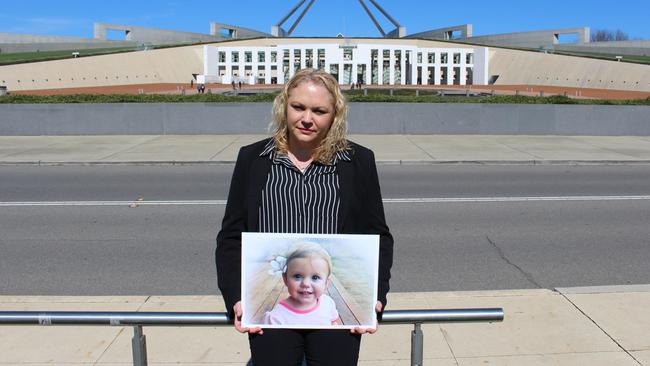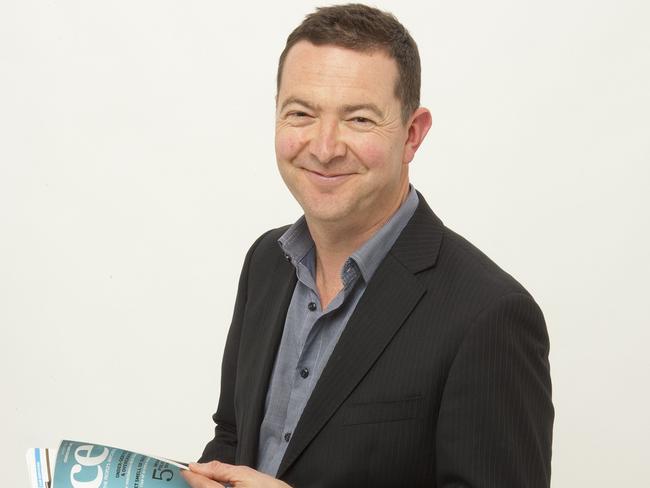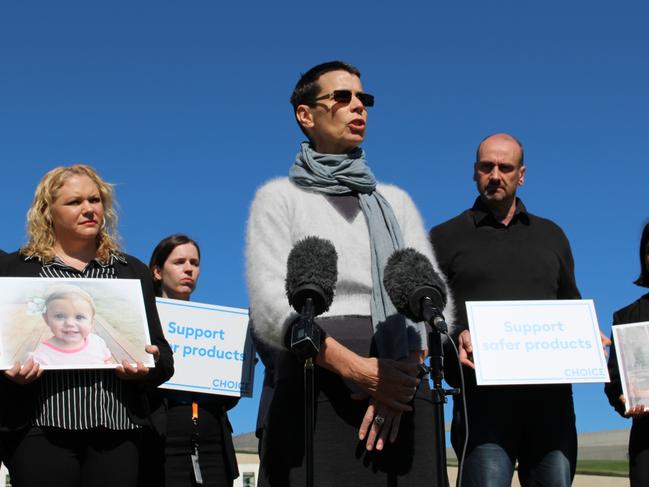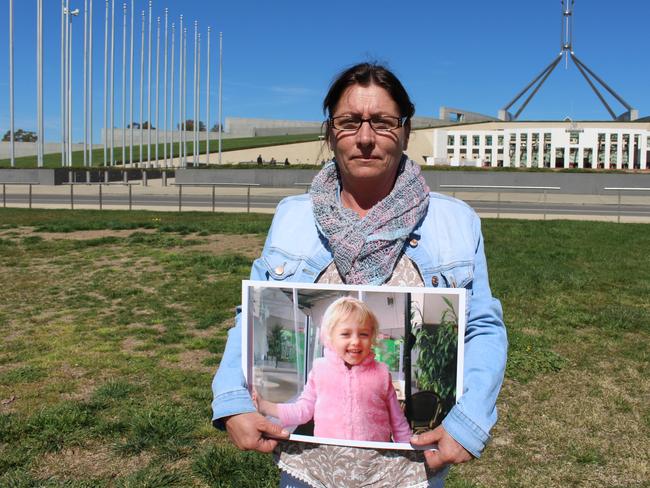‘Landmines in our lounge room’: Parents demand stronger product safety laws
Two mums whose daughters died after swallowing button batteries have become the face of a campaign calling for new laws making it illegal to sell unsafe toys

Canberra Star
Don't miss out on the headlines from Canberra Star. Followed categories will be added to My News.
- Canberra Raiders centre taking shape
- Ex pollies still wielding power
- Comanchero resigns from gang
- Most powerful donors
To this day Allison Rees does not know what product contained the button battery that claimed her daughter’s life.
Isabella was just 14-months-old when she came down with a fever and started vomiting in February 2015.
As doctors suspected she had virus, an X-ray wasn’t performed until her fourth visit to the emergency department.

By then it was too late. Bella had started to bleed from her oesophagus.
More than four years later, Ms Rees is still fighting for stronger product safety laws to prevent other parents going through the same pain she has.
Button batteries are found in a plethora of toys and household products including flashing wristbands, rings, watches, Christmas decorations, greeting cards, audio books and kitchen scales.
Consumer advocacy group CHOICE found 10 out of 17 button battery-powered household items were dangerous.
But it is not just batteries which can potentially turn a seemingly innocuous item found on a supermarket shelf into a lethal product causing injury or even death.
See the top five list from CHOICE of unexpectedly dangerous products for children below.
Ms Rees has become one of the faces of a campaign led by the group calling on the Government to introduce a law making it illegal to sell any unsafe product.
“Isabella was such a beautiful girl and brought so much joy to my life,” Ms Rees said.
“She had an infectious smile and she lit up the room every time she came in.
“Not having her in my life is truly heartbreaking and I’d do anything to have her back.”

She spent “many sleepless nights” searching her home for the battery which stole her daughter from her but came up empty-handed.
“I would like to see the Government make a law that if retailers are going to sell a product containing a button battery, that the consumer is aware at the point of sale this item has one and there is a danger.”
Choice CEO Alan Kirkland said most consumers assume there has been basic checks to ensure a product is not going to cause serious injury or death before it was placed on supermarket shelves.
“But that is not what the law requires,” he said.
“We see products that can cause suffocation, we see strollers that can cause a child to be strangled, we see cot mattresses that could also cause a child to suffocate if they roll over in the night.”

More than 50 per cent of the 173 cots tested by the group since 2012 had failed and 83 per cent of 163 strollers tested since 2012 failed, as did 98 per cent of 60 portable cots tested since 2011.
Mr Kirkland said the Federal Government had for two years a report recommending it should be illegal to sell unsafe products.
CHOICE also wants fines of $10 million for companies which release products which result in injury or death.
Emergency paediatrician Ruth Barker said 20 children a week present to emergency departments after swallowing button batteries.
There had been two deaths and 17 cases of children being seriously injured after swallowing the tiny batteries since December 2017.
She said some children are lucky in that the battery passes through their system but sometimes the batteries lodge in the oesophagus and those children are “walking dead”.

“These products look really innocuous but they are landmines in our lounge rooms,” Ms Barker said.
“If a battery has sufficient charge; 1.2 volts is enough, once it lodges in a place where that place moist, it converts the water into sodium hydroxide, which is oven cleaner.
“So essentially what you have is a foreign body sitting in the oesophagus that is releasing oven cleaner which eats through tissue.
“These are toxic products that should be labelled with the poisons information number.”
Andrea Shoesmith’s daughter Summer Steer died when she was four-year-old after swallowing a button battery in June 2013.
“She was the sunshine of my life, I miss her terribly and while we’ve raised a lot of awareness, we need solid laws to ensure products with button batteries are packaged, secured and disposed of safely.”
Doctors had initially thought Summer had Giardia and then a nosebleed.
She started vomiting blood and collapsed after being sent home. By the time an X-ray discovered the battery, it was too late.

Kidsafe Queensland CEO Susan Teerds said inaction had been going on for too long.
“Do we need more children to die before we do something about this?” she said.
On Wednesday, Ms Shoesmith and Ms Rees hand-delivered a petition to Assistant Treasurer Michael Sukkar signed by more than 25,700 people — one of Choice’s fastest-ever growing petitions — calling for stronger product safety laws.
Mr Sukkar said the Government issued a Safety Warning Notice warning the Australian public about the dangers of button batteries in March.

In addition, the Australian Competition and Consumer Commission (ACCC) has established a taskforce to conduct an investigation into button battery safety and consider regulatory options to address the issue.
The ACCC released an Issues paper in August on button battery safety for public consultation with submissions closing on September 30.
The ACCC will consider submissions on this Issues Paper before making any recommendation about development of new regulation.
Campaign information here or here.
Button batteries found in
— Scales (bathroom, kitchen)
— Remotes
— Medical devices (thermometers, glucose monitors)
— Torches
— Children’s books with audio or lighting
— Cheap electronic toys
Five most dangerous products for children
1. Button Batteries: They’re easy for children to swallow, and if they become stuck on the way to the stomach they can cause severe burning and even death.
2. Bunk beds: Insufficient guardrails and unsafe gaps can cause falls, limb injuries and even strangulation or accidental hanging.
3. Cots: The most common cause of injuries is children falling from the cot. Other serious hazards can include head and limb entrapment and strangulation.
4. Baby walkers: Can lead to children falling down stairs. They can also let infants access hazards they couldn’t otherwise reach like benchtops, ovens and utensil drawers.
5. Vaporisers: The hot steam can cause third degree burns and poisoning can occur if children swallow the essential oils used in the vaporiser.
IN OTHER NEWS
